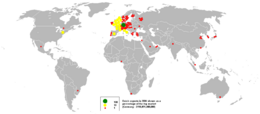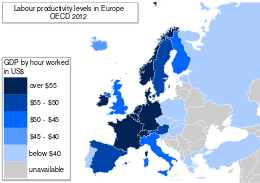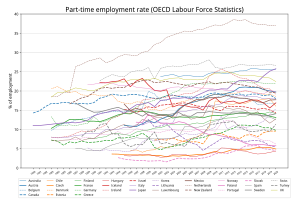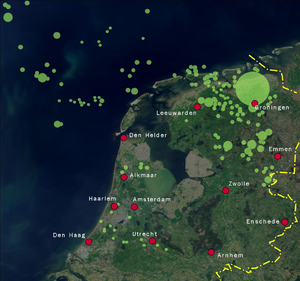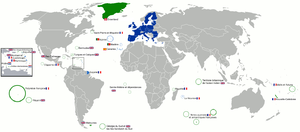اقتصاد هولندا
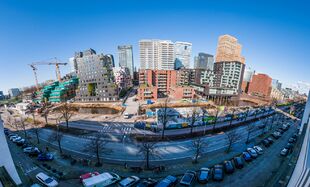 | |
| العملة | Euro (EUR, €) |
|---|---|
| Calendar year | |
منظمات التجارة | EU, WTO and OECD |
| احصائيات | |
| السكان | ▲ 17,589,513 (6 January 2022)[1] |
| ن.م.إ | |
| ترتيب ن.م.إ | |
نمو ن.م.إ |
|
ن.م.إ للفرد | |
ن.م.إ للفرد |
|
السكان تحت خط الفقر | |
| ▼ 26.8 low (2019, Eurostat)[6] | |
القوة العاملة | |
القوة العاملة حسب المهنة |
|
| البطالة | |
متوسط الراتب الإجمالي | €2,855 monthly (2017) |
| €2,152 monthly (2017) | |
الصناعات الرئيسية | Agriculture, oil and natural gas, metal and engineering products, electronic machinery and equipment, chemicals, petroleum, construction, microelectronics, fishing |
| الخارجي | |
| الصادرات | |
السلع التصديرية | Machinery and transport equipment, chemicals, mineral fuels, food and livestock, manufactured goods |
شركاء التصدير الرئيسيين |
|
| الواردات | ▲ $453.8 billion (2017 est.)[3] |
السلعة المستوردة | Machinery and transport equipment, chemicals, fuels, foodstuffs, clothing |
شركاء الاستيراد الرئيسيين |
|
رصيد ا.أ.م | |
| ▲ $90.207 billion (2019 est.)[3] | |
إجمالي الديون الخارجية | ▼ $4.345 trillion (2019 est.)[3] |
| المالية العامة | |
| العوائد | 43.6% of GDP (2019)[11] |
| النفقات | 41.9% of GDP (2019)[11] |
| المعونات الاقتصادية | €4 bn (اعتبارا من 2005[تحديث]) |
احتياطيات العملات الأجنبية | ▲ $38.44 billion (31 December 2017 est.)[3] |
كل القيم، ما لم يُذكر غير ذلك، هي بالدولار الأمريكي. | |
| الحياة في هولندا |
|---|
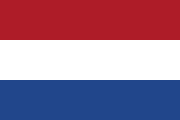 |
اقتصاد هولندا ، وفقًا لمجلة فوربس ، يحتل المرتبة الخامسة عشر في العالم اعتبارًا من عام 2022 من حيث الناتج المحلي الإجمالي. قُدّر نصيب الفرد من الناتج المحلي الإجمالي بـ 68،572 دولارًا في السنة المالية 2022 ، مما يجعلها واحدة من أكثر الدول دخلاً في العالم .
تتمتع هولندا بموارد ثابتة من الغاز الطبيعي منذ عام 1959 ، عندما تم اكتشاف منبع آبار. تمثل هولندا حاليًا أكثر من 25٪ من إجمالي احتياطيات الغاز الطبيعي في الاتحاد الأوروبي . على مدى العقود التالية ، ولّد بيع الغاز الطبيعي زيادة كبيرة في الإيرادات لهولندا. [16] ومع ذلك ، أثرت العواقب غير المتوقعة لثروة الطاقة في البلاد في الأصل على القدرة التنافسية لقطاعات أخرى من الاقتصاد ، مما أدى إلى نظرية المرض الهولندي ، بعد اكتشاف حقل غاز جرونينجن الواسع . [16]
تتمتع هولندا باقتصاد مزدهر ومنفتح ، يعتمد بشكل كبير على التجارة الخارجية . يُلاحظ الاقتصاد للعلاقات الصناعية المستقرة ، والبطالة المنخفضة إلى حد ما ، والتضخم ، وفائض كبير في الحساب الجاري (والذي ، مقارنة بحجم البلد ، أكبر حتى من ألمانيا) ودور مهم كمركز نقل أوروبي ؛ روتردام هي أكبر ميناء في أوروبا. وأمستردام لديها واحد من أكبر المطارات في العالم . يتمثل النشاط الصناعي بالدرجة الأولى في معالجة الأغذية والمواد الكيميائية وتكرير البترول والتكنولوجيا الفائقة والخدمات المالية والقطاع الإبداعي والآلات الكهربائية. لا يوظف قطاعها الزراعي الآلي للغاية أكثر من 2٪ من القوى العاملة ، ولكنه يوفر فوائض كبيرة لصناعة تجهيز الأغذية وللتصدير. بدأت هولندا ، مع 11 من شركائها في الاتحاد الأوروبي ، في تداول عملة اليورو في 1 يناير 2002.
تم التخلي عن السياسة المالية الصارمة في عام 2009 ، بسبب أزمات الائتمان الحالية. تم تأميم القطاع المصرفي الضخم نسبيًا جزئيًا وإنقاذه من خلال التدخلات الحكومية. انخفض معدل البطالة إلى 5.0٪ في صيف 2011 ، لكنه ارتفع بمعدل حاد إلى 7.3٪ في مايو 2013 ، و 6.8٪ في 2015. وانخفض مرة أخرى إلى 3.9٪ في مارس 2018. [17][18] الدولة بلغ عجز الميزانية حوالي 2.2٪ في عام 2015 ، وهو أقل بكثير من المعدل الطبيعي البالغ 3.0٪ في الاتحاد الأوروبي. في عام 2016 [19]، أظهرت ميزانية الدولة فائضًا بنسبة 0.4٪. كان من المتوقع أن ينمو إلى فائض يزيد عن 1.0٪ في عام 2017. [20]تاريخيًا ، قدم الهولنديون واخترعوا سوق الأسهم ، والتي ركزت في البداية علىتجارة البضائع من خلال شركة الهند الشرقية الهولندية . [21]هولندا عضو مؤسس في الاتحاد الأوروبي ومنظمة التعاون الاقتصادي والتنمية ومنظمة التجارة العالمية .
. . . . . . . . . . . . . . . . . . . . . . . . . . . . . . . . . . . . . . . . . . . . . . . . . . . . . . . . . . . . . . . . . . . . . . . . . . . . . . . . . . . . . . . . . . . . . . . . . . . . . . . . . . . . . . . . . . . . . . . . . . . . . . . . . . . . . . . . . . . . . . . . . . . . . . . . . . . . . . . . . . . . . . . .
التاريخ
After declaring its independence from the empire of Philip II of Spain in 1581, the Netherlands experienced almost a century of explosive economic growth. A technological revolution in shipbuilding and trade knowledge and capital, due to Protestant traders of Flanders who fled to the Netherlands, helped the young Republic become the dominant trade power by the mid-17th century. In 1670 the Dutch merchant marine totalled 568,000 tons of shipping—about half the European total. The main reasons for this were the dominance of the Amsterdam Entrepôt in European trade, and that of the Dutch East India Company (or Verenigde Oost-Indische Companie – VOC) and West India Companies in intercontinental trade. Unique was that the V.O.C. was the first multinational, while its shares were traded at the Amsterdam stock exchange, one of the first in the world. Beside trade, an early "industrial revolution" (powered by wind, water and peat), land reclamation from the sea, and agricultural revolution, helped the Dutch economy achieve the highest standard of living in Europe (and presumably the world) by the middle of the 17th century. Affluence facilitated what is known as the Dutch Golden Age. This economic boom abruptly came to an end by a combination of political-military upheavals and adverse economic developments around 1670. Still the Netherlands kept a high level of prosperity, due to trade and agriculture.
Towards the 1800s, the Netherlands did not industrialize as rapidly as some other countries in Europe. One explanation for this is that the Netherlands were struggling to come to terms with having lost their dominant economical (based mainly on trade and agriculture) and political position in the world. Griffiths argues that government policies made possible a unified Dutch national economy in the 19th century. They included the abolition of internal tariffs and guilds; a unified coinage system; modern methods of tax collection; standardized weights and measures; and the building of many roads, canals, and railroads.
The rest of Europe in the 19th century saw the gradual transformation of the Netherlands into a modern middle-class industrial society. The number of people employed in agriculture decreased while the country made a heroic effort to revive its stake in the highly competitive industrial and trade business. The Netherlands lagged behind Belgium until the late 19th century in industrialization, then caught up by about 1920. Major industries included textiles and (later) the great Philips industrial conglomerate. Rotterdam became a major shipping and manufacturing center.[22] Poverty slowly declined and begging largely disappeared along with steadily improving working conditions for the population.
Since 1959, the Netherlands discovered large natural gas fields. The export of natural gas led to large windfall profits. However, as an unforeseen consequence, these were believed to have led to a decline in the manufacturing sector in the Netherlands.[23]
الحكومة
While the private sector is the cornerstone of the Dutch economy, governments at different levels have a large part to play. Public spending, excluding social security transfer payments, was at 28% of GDP in 2011.[24] Total tax revenue was 38.7% of GDP in 2010,[25] which was below the EU average.[26] In addition to its own spending, the government plays a significant role through the permit requirements and regulations pertaining to almost every aspect of economic activity. The government combines a rigorous and stable microeconomic policy with wide-ranging structural and regulatory reforms. The government has gradually reduced its role in the economy since the 1980s. Privatisation and deregulation is still continuing. With regards to social and economic policy, the government cooperates with its so called social partners (trade unions and employers' organizations). The three parties come together in the Social-Economic Council (‘Sociaal Economische Raad’), the main platform for social dialogue.
نظام الضمان الاجتماعي
The Dutch social security is very comprehensive, covering Dutch residents in an encompassing manner and is divided into the national security (Volksverzekeringen) and the employee insurance (Werknemersverzekeringen). Whereas the first covers all living in the Netherlands and the social benefits provided, the latter provides employment-related benefits.[27] All living in the Netherlands are required to pay into the social security system, including residents from outside the Netherlands, with a few exceptions.[28]
The Volksverzekeringen is compulsory for all and covers the residents under different forms of national insurance:[29][30]
- Long-term care under the Long-Term Care Act (Wet Langdurige Zorg (WLZ)) (formerly known as The Exceptional Medical Expenses Act (Algemen Wet Bijzondere Ziektekosten (AWBZ)))
- Pension care under the General Old Age Pensions Act (Algemene Ouderdomswet (AOW))
- Survivor benefits under the General Surviving Relatives Act (Algemene nabestaandenwet( ANW)) (formerly known as The General Widow's and Orphans’ Act (Algemene Weduwen-en Wezenwet (AWW)))
- Child benefits under the General Family Allowances Act (Algemene Kinderbijslagwet (AKW))
It is overseen by the Social Insurance Bank (Sociale Verzekeringsbank (SVB)) and financed through earning-related contributions of employers and employees up until a maximum income-ceiling. Whilst employed persons get their contribution deducted automatically from their wage, the unemployed pay by themselves. The AKW is financed by employers, whereas the AOW is financed by the employees. The AOW, additionally, is financed by a small government subsidy.
The Werknemersverzekeringen is compulsory for all employed people within the Netherlands. It includes the coverage of employees in the following areas:
- Unemployment benefits under the Unemployment Insurance Act (Werkloosheidswet (WW))
- Sick leave under the Sickness Benefits Act (Ziektewet (ZW))
- Disability benefits under the Disablement Insurance Act (Wet werk en inkomen naar arbeidsvermogen (WIA))
The financing for the Werknemersverkeringen is automatically deducted from the employee's income by the employer.[29][30]
مزايا البطالة
التغطية
The unemployment benefits in the Netherlands, as set out under the WW, covers almost all employees, that are employees based on a working-contract. Excluded from the WW are the following: self-employed, nationally employed, persons working less than four days a week, heads of stockholders and voluntary workers that earn up to €150 per year.[27][30]
الحق في المزايا
To profit from the benefit the unemployed has to submit an application to the Employee Insurance Agency (Uitvoeringsinstituut Werknemersverzekeringen (UWV)) within one week of becoming unemployed and additionally has to register as job-seeker. The WW only covers employees with a sufficient work history, meaning that an applicant has to have been working for at least 26 weeks in the past 36 weeks before becoming unemployed. If so, the working-weeks requirement is met. Moreover, the employee is only eligible to unemployment benefits if the unemployment has not been due to his own fault (e.g. own termination of the job contract).[27][30]
المزايا
The benefits received through the WW are earnings-related and amount to a sum of 75% percent of the previous earnings per day (which is based on 5 working days per week) for the duration of two months. After those two months the benefits amount to 70%. Part-time work is taken into account with a calculation of parts of the working hours. If this benefit is less than the minimum income, the unemployed has the possibility of supplementation through the Additional Allowances Act (Toeslagenwet) to sum up the amount. All jobs in the previous twelve months are counted in to the calculation of the benefits, if a change of work has taken place. To obtain the benefits for a continued time, the unemployed needs to be actively looking for work. Moreover, one needs to participate in e-coaching three and twelve months after the start of unemployment. After one year of unemployment one must register with an employment agency.[28][30][29]
القضايا الجدالية
سوق العمل والضمان الاجتماعي
The Dutch labour market has relatively strict regulations for employers on firing employees, although by June 2014 the House of Representatives has agreed to loosen these regulations.[needs update] Due to the costs of employees and costs of firing them, a big part of the working force (about 15% of the working force) is an independent one person company (ZZP). They are independent and get paid by delivery without higher social costs.[مطلوب توضيح] Another big part of the workforce is hired as temporary workforce. State unemployment benefits in the form of a 70% benefit of the employee's last-earned salary for up to three years (with a maximum of roughly 2500 euros per month) are available for fired employees, provided that they have worked for a certain minimum time period, usually 26 weeks. Moreover, the self-employed individuals (zelfstandigen zonder personeel (ZZP)) are not automatically covered under the Werknemersverzekeringen, and are not obligated to enroll into unemployment, sickness or disabilities insurance. Self-employed individuals, hence, are required to enroll themselves with private insurance companies.[29][31]
عمر التقاعد
Every Dutch citizen gets according to the AOW act of 1956, a state pension, from the age of 65. The act was amended in 2012 that makes the age in several stages up to 67 years in 2024 . Married couples or those who live together receive 50% of minimum wage per person and a single person receives 70% of minimum wage. Most (about 70%) earn an extra pension from private pension funds. Employees are obliged to take part in the sector pension funds.[مطلوب توضيح] In total the amount of pension funds were at the end of 2009 some 664 billion euro and at the end of 2019 1560 billion euro for something more than 17 million people. Employees receive on average about 70% of their last salary. During the economic crisis[which?] and because of low interest rates, pensions funds have had difficulty keeping up with inflation. The Dutch pension system is regarded as one of the bestقالب:How in the world.[32][33]
عدم المساواة وإعادة التوزيع
With a Gini coefficient of 25.1 (2013) the income inequality is relatively low in the Netherlands. However, the inequality when measured in distributions of household wealth is high, where the top 1% owns 24% of all net wealth, and the top 10% own 60%. Moreover, rather large wealth disparities persist in the Netherlands in relation to age, where those under 35 years-of-age own 10% as much as older workers. This is a consequence from the low taxation of home ownership and a generous mortgage interest deductibility, which benefit the wealthier households.[34] Due to the generous pensions the pension-related savings are the most important part of wealth in the Netherlands, yet are not subject to capital income taxation, which increases the inequality.
. . . . . . . . . . . . . . . . . . . . . . . . . . . . . . . . . . . . . . . . . . . . . . . . . . . . . . . . . . . . . . . . . . . . . . . . . . . . . . . . . . . . . . . . . . . . . . . . . . . . . . . . . . . . . . . . . . . . . . . . . . . . . . . . . . . . . . . . . . . . . . . . . . . . . . . . . . . . . . . . . . . . . . . .
Home mortgage interest deduction
The Netherlands was one of the few countries in the world where the interest paid on mortgages is almost fully deductible from income tax. Since 2013 big changes were made. The conditions allowing a borrowing of more than 116% of the value of the home were reduced to 106% and are still continuously being reduced every year. The deduction is also capped to 50.5% and reducing every year.[35] Together with the after-effects of the financial crisis of 2007–2008 the result was a housing crisis, with a decrease of prices almost 25% percent in some areas. Recent years have shown a recovery of 10% to even 20% per year in the most popular cities.
The Service sector accounts for more than half of the national income, primarily in transportation, distribution and logistics, financial areas, software development and the creative industry. The breadth of service providers in financial services and a Protestant work ethic have contributed to the Netherlands achieving a DAW Index score of 5 in 2012. Industrial activity is dominated by the machinery, electronics/high tech industry, metalworking, oil refining, chemical, and food-processing industries. Construction amounts to about 6% of GDP. Agriculture and fishing, although visible and traditional Dutch activities, account for just 2%.
The Netherlands continues to be one of the leading European nations for attracting foreign direct investment and is one of the five largest investors in the United States. The economy experienced a slowdown in 2005, but in 2006 recovered to the fastest pace in six years on the back of increased exports[36] and strong investment. The pace of job growth reached 10-year highs in 2007. The Netherlands is the fifth-most competitive economy in the world, according to the World Economic Forum's Global Competitiveness Report.[37]
القطاعات الرئيسية
الزراعة
The Netherlands produced, in 2018:[38]
- 14 million tons cows milk (milk, cheese, butter, milk powder, infant formula)
- 6.5 million tons of sugar beet, which is used to produce sugar and ethanol;
- 6.0 million tonnes of potato (10th largest producer in the world);
- 9999.523 million tons of onion;
- 961 thousand tons of wheat;
- 910 thousand tons of tomatoes;
- 538 thousand tons of carrots;
- 410 thousand tons of cucumber;
- 402 thousand tons of pear;
- 355 thousand tons of peppers;
- 300 thousand tons of mushroom and truffle;
- 295 thousand tons of lettuce;
- 269 thousand tons of apple;
- 247 thousand tons of barley;
In addition to smaller productions of other agricultural products.[39]
قطاع الطاقة
الغاز الطبيعي

The discovery of the large Groningen natural gas field in 1959 and the massive windfalls accrued over subsequent decades, were believed to have led to a decline in the manufacturing sector in the Netherlands,[23] leading to the theory of Dutch disease.[16]
While its oil reserves in the North Sea are of little importance, the Netherlands have an estimated 25% of natural gas reserves in the EU.[40] Natural gas reserves of the Netherlands are estimated (as of 2014) to be about 600 billion cubic feet,[41] or about 0.3% of the world total. In 2014–2015 the government decided to reduce the production of gas in the province Groningen significantly due to problems of sinking ground, differential settlement levels and tremors (small earth quakes) causing damages to properties, end 2018 the government decided to completely abandon the gas production in the province of Groningen by reducing the production slightly each year, the production is expected to disappear entirely in 2028[42]
To reduce its greenhouse emissions, the government of the Netherlands is subsidizing a transition away from natural gas for all homes in the country by 2050.[43]
الطاقة النووية
Researchers in the Netherlands began studying nuclear energy in the 1930s and began construction of research reactor Dodewaard in 1955. Researchers’ goal was to introduce nuclear power technology by 1962 and replace fossil fuels. In 1968, a test nuclear reactor was attached to the power grid. This unit was shut down in 1997. In the 1970s, the Dutch chose a policy that required reprocessing all spent nuclear fuel. In 1984, the government decided to create a long-term (100 years) storage facility for all intermediate and low-level radioactive waste and research strategies for ultimate disposal. In September 2003, the Central Organization for Radioactive Waste created an interim storage facility for high-level waste. The Netherlands' only commercial nuclear reactor is Borssele, which became operational in 1973 and اعتبارا من 2011[تحديث] produces about 4% of the country's electricity.[44] The older Dodewaard nuclear power plant was a test reactor that later got attached to the national grid but was closed in 1997. A 2MW research reactor is located in Delft, as part of the physics department of Delft University of Technology. This reactor is not meant for energy provision, but used as a neutron and positron source for research.
In 1994, the States General of the Netherlands voted to phase out nuclear power after a discussion of nuclear waste management. In 1997, the power station at Dodewaard was shut down and the government decided it was planning to end Borssele's operating license in 2003. This has since been postponed to 2034, if it complied with the highest safety standards.[بحاجة لمصدر] After the 2010 election, the new government was open to expanding nuclear power. Both of the companies that share ownership of Borssele are proposing to build new reactors.[45][46] In January 2012, Delta announced it postpones any decision to start building a second nuclear power plant.
السياحة
In 2011, the Netherlands was visited by 11.3 million foreign tourists.[47] In 2012, the Dutch tourism industry contributed 5.4% in total to the country's GDP and 9.6% in total to its employment. With its global ranking of 147th and 83rd place for total contribution to respectively GDP and employment, tourism is a relatively small sector of the Dutch economy.[48] North Holland was by far the most popular province for foreign tourists in 2011. Out of all 11.3 million tourists, 6 million visited North Holland. South Holland took the second place with 1.4 million. Germans, Britons and Belgians made up the majority of foreign tourists, respectively 3, 1.5 and 1.4 million.[49] As of 2020, there are nine World Heritage Sites in the Netherlands. The Netherlands are well known for their art and rich historical heritage.
البيانات
The following table shows the main economic indicators in 1980–2021 (with IMF staff estimates in 2022–2027). Inflation under 5% is in green. [50]
| Year | GDP
(in Bil. US$PPP) |
GDP per capita
(in US$ PPP) |
GDP
(in Bil. US$nominal) |
GDP per capita
(in US$ nominal) |
GDP growth
(real) |
Inflation rate
(in Percent) |
Unemployment
(in Percent) |
Government debt
(in % of GDP) |
|---|---|---|---|---|---|---|---|---|
| 1980 | 165.0 | 11,708.1 | 193.8 | 13,750.5 | n/a | n/a | 3.4% | 43.6% |
| 1981 | ▲179.7 | ▲12,644.4 | ▲6.8% | ▲4.6% | ▲46.9% | |||
| 1982 | ▲188.3 | ▲13,181.8 | ▲5.9% | ▲6.5% | ▲52.5% | |||
| 1983 | ▲199.1 | ▲13,886.6 | ▲1.8% | ▲2.9% | ▲8.3% | ▲58.5% | ||
| 1984 | ▲212.7 | ▲14,779.7 | ▲3.1% | ▲3.4% | ▼8.1% | ▲62.0% | ||
| 1985 | ▲225.3 | ▲15,587.9 | ▲144.7 | ▲10,008.0 | ▲2.7% | ▲2.3% | ▼7.3% | ▲67.2% |
| 1986 | ▲237.0 | ▲16,313.5 | ▲201.6 | ▲13,875.2 | ▲3.1% | n/a | ▼6.5% | ▲69.0% |
| 1987 | ▲247.4 | ▲16,926.4 | ▲246.9 | ▲16,895.4 | ▲1.9% | ▲-1.0% | ▼6.3% | ▲71.4% |
| 1988 | ▲267.8 | ▲18,202.4 | ▲264.2 | ▲17,956.1 | ▲4.6% | ▲0.5% | ▼6.2% | ▲73.8% |
| 1989 | ▲290.8 | ▲19,643.3 | ▲4.5% | ▲1.1% | ▼5.7% | |||
| 1990 | ▲314.3 | ▲21,105.3 | ▲321.4 | ▲21,581.6 | ▲4.2% | ▲2.5% | ▼5.1% | ▲75.1% |
| 1991 | ▲332.9 | ▲22,178.4 | ▲331.1 | ▲22,057.8 | ▲2.5% | ▲3.2% | ▼4.8% | ▼74.9% |
| 1992 | ▲345.9 | ▲22,863.5 | ▲366.0 | ▲24,192.0 | ▲1.6% | ▲2.8% | ▲4.9% | ▲75.7% |
| 1993 | ▲358.6 | ▲23,530.1 | ▲1.3% | ▲1.6% | ▲5.5% | ▲76.8% | ||
| 1994 | ▲377.3 | ▲24,590.5 | ▲382.6 | ▲24,935.5 | ▲3.0% | ▲2.1% | ▲6.2% | ▼73.6% |
| 1995 | ▲395.8 | ▲25,664.2 | ▲452.7 | ▲29,350.8 | ▲2.8% | ▲1.3% | ▲7.7% | ▼72.2% |
| 1996 | ▲417.2 | ▲26,925.6 | ▲3.5% | ▲1.4% | ▼7.1% | ▼70.5% | ||
| 1997 | ▲442.7 | ▲28,440.8 | ▲4.3% | ▲1.9% | ▼6.1% | ▼64.9% | ||
| 1998 | ▲468.6 | ▲29,936.1 | ▲438.6 | ▲28,018.7 | ▲4.7% | ▲1.8% | ▼4.9% | ▼61.7% |
| 1999 | ▲499.1 | ▲31,671.1 | ▲447.5 | ▲28,393.8 | ▲5.0% | ▲2.0% | ▼4.1% | ▼57.5% |
| 2000 | ▲531.9 | ▲33,528.1 | ▲4.2% | ▲2.3% | ▼3.7% | ▼50.9% | ||
| 2001 | ▲556.5 | ▲34,811.4 | ▲431.6 | ▲26,996.2 | ▲2.3% | ▲5.1% | ▼3.1% | ▼48.2% |
| 2002 | ▲566.4 | ▲35,170.5 | ▲473.5 | ▲29,402.0 | ▲0.2% | ▲3.9% | ▲3.7% | ▼47.5% |
| 2003 | ▲578.5 | ▲35,727.5 | ▲579.9 | ▲35,814.3 | ▲0.2% | ▲2.2% | ▲5.9% | ▲48.7% |
| 2004 | ▲605.8 | ▲37,263.5 | ▲658.1 | ▲40,477.3 | ▲2.0% | ▲1.4% | ▲6.8% | ▲49.1% |
| 2005 | ▲637.6 | ▲39,104.4 | ▲685.7 | ▲42,054.9 | ▲2.0% | ▲1.5% | ▲7.0% | ▼48.5% |
| 2006 | ▲680.0 | ▲41,633.3 | ▲734.0 | ▲44,936.0 | ▲3.5% | ▲1.7% | ▼6.1% | ▼44.1% |
| 2007 | ▲724.8 | ▲44,306.7 | ▲848.7 | ▲51,880.4 | ▲3.8% | ▲1.6% | ▼5.3% | ▼42.0% |
| 2008 | ▲754.7 | ▲46,003.9 | ▲951.8 | ▲58,015.4 | ▲2.2% | ▲2.2% | ▼4.8% | ▲53.8% |
| 2009 | ▲1.0% | ▲5.4% | ▲55.8% | |||||
| 2010 | ▲750.4 | ▲45,274.1 | ▲1.3% | ▲0.9% | ▲6.1% | ▲59.4% | ||
| 2011 | ▲777.9 | ▲46,703.3 | ▲905.1 | ▲54,342.1 | ▲1.6% | ▲2.5% | ▲61.8% | |
| 2012 | ▲792.0 | ▲47,341.6 | ▲2.8% | ▲6.8% | ▲66.4% | |||
| 2013 | ▲827.5 | ▲49,314.5 | ▲877.2 | ▲52,277.0 | ▲2.6% | ▲8.2% | ▲67.8% | |
| 2014 | ▲830.3 | ▲49,337.7 | ▲892.4 | ▲53,026.5 | ▲1.4% | ▲0.3% | ▲8.3% | ▲68.0% |
| 2015 | ▲852.1 | ▲50,418.7 | ▲2.0% | ▲0.2% | ▼7.9% | ▼64.6% | ||
| 2016 | ▲890.4 | ▲52,440.8 | ▲783.8 | ▲46,165.2 | ▲2.2% | ▲0.1% | ▼7.0% | ▼61.9% |
| 2017 | ▲948.2 | ▲55,509.3 | ▲833.6 | ▲48,799.9 | ▲2.9% | ▲1.3% | ▼5.9% | ▼56.9% |
| 2018 | ▲993.8 | ▲57,839.9 | ▲914.5 | ▲53,224.7 | ▲2.4% | ▲1.6% | ▼4.9% | ▼52.4% |
| 2019 | ▲1,031.3 | ▲59,674.9 | ▲2.0% | ▲2.7% | ▼4.4% | ▼48.5% | ||
| 2020 | ▲1.1% | ▲4.9% | ▲54.6% | |||||
| 2021 | ▲1,095.4 | ▲62,685.0 | ▲1,013.5 | ▲57,996.9 | ▲4.9% | ▲2.8% | ▼4.2% | ▼52.3% |
| 2022 | ▲1,226.7 | ▲69,714.5 | ▲4.5% | ▲12.0% | ▼3.5% | ▼48.3% | ||
| 2023 | ▲1,280.5 | ▲72,363.5 | ▲1,019.8 | ▲57,628.6 | ▲0.8% | ▲8.0% | ▲3.9% | ▼46.4% |
| 2024 | ▲1,329.6 | ▲74,842.4 | ▲1,077.0 | ▲60,620.9 | ▲1.7% | ▲2.7% | ▲4.0% | ▼45.6% |
| 2025 | ▲1,376.0 | ▲77,235.7 | ▲1,125.5 | ▲63,173.5 | ▲1.6% | ▲2.3% | ▲4.2% | ▲46.2% |
| 2026 | ▲1,424.2 | ▲79,717.7 | ▲1,173.5 | ▲65,684.3 | ▲1.6% | ▲2.0% | ▲4.4% | ▲47.2% |
| 2027 | ▲1,474.1 | ▲82,280.9 | ▲1,223.4 | ▲68,285.1 | ▲1.5% | ▲2.0% | ▲4.6% | ▲48.1% |
. . . . . . . . . . . . . . . . . . . . . . . . . . . . . . . . . . . . . . . . . . . . . . . . . . . . . . . . . . . . . . . . . . . . . . . . . . . . . . . . . . . . . . . . . . . . . . . . . . . . . . . . . . . . . . . . . . . . . . . . . . . . . . . . . . . . . . . . . . . . . . . . . . . . . . . . . . . . . . . . . . . . . . . .
أكبر الشركات
The Netherlands is home to several large multinationals. Well-known multinationals are Heineken, Ahold, Philips, TomTom, Randstad and ING, all of which have their headquarters in Amsterdam. Thousands of companies of non-Dutch origin have their headquarters in the Netherlands, like EADS, LyondellBasell and IKEA, because of attractive Corporate tax levels.[بحاجة لمصدر]
The Netherlands' biggest companies as of 2011 are as following:
| Rank[51] | Name | Headquarters | Revenue
(Mil. €) |
Profit
(Mil. €) |
Employees
(World) |
|---|---|---|---|---|---|
| 2. | ING Group | Amsterdam | 147,052 | 3,678 | 106,139 |
| 3. | Aegon | The Hague | 65,136 | 2,330 | 27,474 |
| 4. | Airbus | Leiden | 60,597 | 732 | 121,691 |
| 5. | LyondellBasell Industries | Rotterdam | 41,151 | N.A. | 14,000 |
| 6. | Royal Ahold | Amsterdam | 39,111 | 1,130 | 122,027 |
| 7. | Royal Philips Electronics | Amsterdam | 33,667 | 1,915 | 119,001 |
| 8. | Rabobank Group | Utrecht | 32,672 | 3,552 | 58,714 |
| 9. | GasTerra | Groningen | 24,313 | 48 | 188 |
| 10. | Heineken Holding | Amsterdam | 21,684 | 954 | 65,730 |
| — | SHV Holdings | Utrecht | 21,202 | 799 | 50,300 |
| — | Akzo Nobel | Amsterdam | 20,419 | 999 | 55,590 |
الاندماجات والاستحواذات
In the Netherlands 22,484 deals were conducted between 1985 and 2018. This sums to an overall value of 2,226.6 billion USD. The year with the most deals has been 2000 with 1,169 deals. However, the most value added up in 2007 with almost 394.9 followed by a drastic slump during the world financial crisis.[52]
Here is a list of the most important deals in, into and out of the Netherlands.
| Date announced | Acquiror name | Acquiror mid-industry | Acquiror nation | Target name | Target mid-industry | Target nation | Value of transaction ($mil) |
| 25 April 2007 | RFS Holdings BV | Other Financials | Netherlands | ABN-AMRO Holding NV | Banks | Netherlands | 98,189.19 |
| 19 March 2007 | Barclays PLC | Banks | United Kingdom | ABN-AMRO Holding NV | Banks | Netherlands | 92,606.80 |
| 28 October 2004 | Royal Dutch Petroleum Co | Oil & Gas | Netherlands | Shell Transport & Trading Co | Oil & Gas | United Kingdom | 74,558.58 |
| 4 August 2015 | Royal Dutch Shell PLC | Petrochemicals | Netherlands | BG Group PLC | Oil & Gas | United Kingdom | 69,445.02 |
| 2 March 2016 | CNAC Saturn (NL) BV | Chemicals | Netherlands | Syngenta AG | Chemicals | Switzerland | 41,840.11 |
| 27 January 2006 | Mittal Steel Co NV | Metals & Mining | Netherlands | Arcelor SA | Metals & Mining | Luxembourg | 32,240.47 |
| 3 September 2017 | PPG Industries Inc | Chemicals | United States | Akzo Nobel NV | Chemicals | Netherlands | 26,560.76 |
| 4 August 2015 | Royal Dutch Shell PLC | Petrochemicals | Netherlands | Royal Dutch Shell PLC | Petrochemicals | Netherlands | 25,000.00 |
| 29 September 2008 | The Netherlands | National Government | Netherlands | Fortis Bank Nederland(Holding) | Banks | Netherlands | 23,137.31 |
| 10 April 2010 | VimpelCom Ltd | Wireless | Netherlands | Weather Investments Srl | Telecommunications Services | Italy | 22,382.31 |
انظر أيضاً
- Bureau for Economic Policy Analysis
- De Nederlandsche Bank (Central Bank of The Netherlands)
- Dutch disease
- Port of Rotterdam
- List of companies of the Netherlands
- Ministry of Finance
- Polder Model (Dutch version of consensus policy in economics)
- Social-Economic Council (economic advisory council of the Dutch government)
- Taxation in the Netherlands
- VNO-NCW (Confederation of Netherlands Industry and Employers)
- BrabantStad
- Randstad
المصادر
- CBS – Statistics agency of the Netherlands
- CPB – Netherlands Bureau for Economic Policy Analysis
- DNB – Dutch central bank
- Eurostat – EU statistics agency
- CIA World Factbook
- Infographic about the relationship of energy to the economy in the Netherlands. Dutch government, 2012
وصلات خارجية
- World Bank Summary Trade Statistics Netherlands
- Useful information about the financial institutions in the Netherlands
- Tariffs applied by the Netherlands as provided by ITC's Market Access Map, an online database of customs tariffs and market requirements
للاستزادة
- van Riel, Arthur. "Review: Rethinking the Economic History of the Dutch Republic: The Rise and Decline of Economic Modernity Before the Advent of Industrialized Growth," The Journal of Economic History, Vol. 56, No. 1 (Mar. 1996), pp. 223–229 in JSTOR
- de Vries, Johan. "Benelux, 1920–1970," in C. M. Cipolla, ed. The Fontana Economic History of Europe: Contemporary Economics Part One (1976) pp 1–71
- Vlekke, Bernard H. M. Evolution of the Dutch Nation (1945) 382 pp. online edition
- Wintle, Michael P. An Economic and Social History of the Netherlands, 1800–1920: Demographic, Economic, and Social Transition (Cambridge University Press, 2000) online edition
- van Zanden, J. L. The Economic History of The Netherlands 1914–1995: A Small Open Economy in the 'Long' Twentieth Century (Routledge, 1997) excerpt and text search
المراجع
- ^ "Population on 1 January". ec.europa.eu/eurostat. Eurostat. Retrieved 13 July 2020.
- ^ أ ب ت ث ج ح خ د "World Economic Outlook Database, October 2020". IMF.org. International Monetary Fund. Retrieved 19 November 2022.
- ^ أ ب ت ث ج ح خ د ذ ر ز "The World Factbook". CIA.gov. Central Intelligence Agency. Archived from the original on 13 May 2022. Retrieved 17 May 2022.
- ^ Marie, Wildeboer Schut, Jean; Stella, Hoff (2 March 2017). "Verwachte armoede in 2015–2017". Armoede in Kaart. 2016 (2016). Retrieved 4 January 2018.
{{cite journal}}: CS1 maint: multiple names: authors list (link) - ^ "People at risk of poverty or social exclusion". ec.europa.eu/eurostat. Eurostat. Retrieved 25 October 2020.
- ^ "Gini coefficient of equivalised disposable income - EU-SILC survey". ec.europa.eu/eurostat. Eurostat. Retrieved 25 October 2020.
- ^ "Labor force, total - Netherlands". data.worldbank.org. World Bank. Retrieved 1 November 2019.
- ^ "Employment rate by sex, age group 20-64". ec.europa.eu/eurostat. Eurostat. Retrieved 16 October 2019.
- ^ أ ب "Unemployment down to pre-pandemic level". CBS.
- ^ "Ease of Doing Business in Netherlands". Doingbusiness.org. Retrieved 21 November 2017.
- ^ أ ب ت ث "Euro area and EU27 government deficit both at 0.6% of GDP" (PDF). ec.europa.eu/eurostat. Eurostat. Retrieved 28 April 2020.
- ^ "Sovereigns rating list". Standard & Poor's.
- ^ أ ب ت Rogers, Simon; Sedghi, Ami (15 April 2011). "How Fitch, Moody's and S&P rate each country's credit rating". The Guardian. Retrieved 31 May 2011.
- ^ "Scope affirms the Netherlands' credit ratings at AAA with Stable Outlook". Scope Ratings. Retrieved 26 November 2022.
- ^ OECD Labour Force Statistics 2020, OECD Labour Force Statistics, OECD, 2020, doi:, ISBN 9789264687714
- ^ أ ب ت Banning, Cees (17 June 2009). "The Dutch curse: how billions from natural gas went up in smoke". NRC Handelsblad. Archived from the original on 21 December 2016.
- ^ "Kerncijfers - arbeid". Centraal Bureau voor de Statistiek. Retrieved 14 April 2012.
- ^ "Unemployment falls below 4 percent". CBS. Retrieved 19 April 2018.
- ^ "Begrotingstekort 2011 valt hoger uit". z24. 17 February 2012. Retrieved 14 April 2012.
- ^ "CBS StatLine - Overheid; Overheidssaldo en overheidsschuld". Statline.cbs.nl. Retrieved 4 January 2018.
- ^ "Missing File" (PDF). 1.worldbank.org. Archived from the original (PDF) on 14 September 2012. Retrieved 4 January 2018.
- ^ Loyen, Reginald; et al. (2003). Struggling for Leadership: Antwerp-Rotterdam Port. Competition 1870–2000. Springer. ISBN 978-3-7908-1524-5.
- ^ أ ب "The Dutch Disease" (26 November 1977). The Economist, pp. 82–83.
- ^ "General government final consumption expenditure (% of GDP)". World Bank. Retrieved 7 April 2013.
- ^ "Total tax revenue as percent of GDP". OECD. Retrieved 7 April 2013.
- ^ "Main national accounts tax aggregates". Eurostat. Retrieved 7 April 2013.
- ^ أ ب ت "Your social security rights in the Netherlands" (PDF). Ec.europa.eu. 2013. Retrieved 4 January 2018.
- ^ أ ب Verzekeringsbank, Sociale. "SVB home - SVB". Svb.nl (in الإنجليزية). Retrieved 5 December 2017.
- ^ أ ب ت ث "Social security in the Netherlands" (in الإنجليزية). Retrieved 27 June 2022.
- ^ أ ب ت ث ج Roebroek, Joop M. (2016). Dixon Scheurell, John Robert P. (ed.). Social Welfare in Developed Market Countries. Routledge. pp. 147–189. ISBN 9781317366775.
- ^ "OECD - Social Policy Division - Directorate of Employment, Labour and Social Affairs : Country chapter - Benefits and Wages : The Netherlands" (PDF). Oecd.org. 2002. Retrieved 4 January 2018.
- ^ "Belangrijkste punten uit het Lente-akkoord". Trouw.nl (in الهولندية). 17 May 2012. Retrieved 4 January 2018.
- ^ "KINGDOM OF THE NETHERLANDS—NETHERLANDS" (PDF). Imf.org. 2016. Retrieved 4 January 2018.
- ^ "In It Together Why Less Inequality Benefits All... in the Netherlands" (PDF). Oecd.org. 2015. Retrieved 4 January 2018.
- ^ "Tariefsaanpassing aftrek kosten eigen woning". Belastingdienst. Archived from the original on 31 January 2017. Retrieved 15 May 2017.
- ^ "Netherlands Business Overview". Archived from the original on 20 April 2020.
- ^ "Global Competitiveness Report 2012–2013". World Economic Forum. 5 September 2012. Archived from the original on 10 December 2014. Retrieved 11 June 2013.
- ^ Netherlands production in 2018, by FAO
- ^ France production in 2018, by FAO
- ^ "The hunt for gas and oil reserves that are more difficult to extract". EBN. Archived from the original on 7 September 2015.
- ^ Focus on Dutch Oil and Gas 2015. EBN. 2015. p. 10. Archived from the original. You must specify the date the archive was made using the
|archivedate=parameter. https://www.ebn.nl/wp-content/uploads/2014/11/10171_EBNfocus_v5.pdf. - ^ "Gas field earthquakes put Netherlands' biggest firms on extraction notice". TheGuardian.com. 23 January 2018.
- ^ "Van der Pekbuurt gaat als eerste Amsterdamse wijk van het aardgas af" (in الهولندية). 1 October 2018.
- ^ "Nuclear Power in the Netherlands". World Nuclear Association (WNA). January 2011. Retrieved 21 February 2011.
- ^ Orlowski, Andrew (10 February 2011). "Holland slashes carbon targets, shuns wind for nuclear". The Register. Retrieved 21 February 2011.
- ^ Gassmann, Michael (8 فبراير 2011). "Energiepolitik: Holland plant strahlende Zukunft". Financial Times Deutschland (in الألمانية). Archived from the original on 11 فبراير 2011. Retrieved 21 فبراير 2011.
- ^ "UNWTO Tourism Highlights, 2013 Edition". United Nations World Tourism Organization. Retrieved 25 August 2013.
- ^ "Netherlands Economic Impact Report". World Travel & Tourism Council. Retrieved 25 August 2013.
- ^ "Toerisme en recreatie in cijfers 2012" (in الهولندية). Statistics Netherlands. Retrieved 25 August 2013.
- ^ "Report for Selected Countries and Subjects".
- ^ "Global 500 - Fortune". Fortune. Retrieved 3 March 2015.
- ^ "M&A Statistics by Countries - Institute for Mergers, Acquisitions and Alliances (IMAA)". Institute for Mergers, Acquisitions and Alliances (IMAA) (in الإنجليزية الأمريكية). Retrieved 26 February 2018.
- CS1 الهولندية-language sources (nl)
- CS1 الألمانية-language sources (de)
- CS1 الإنجليزية الأمريكية-language sources (en-us)
- Short description is different from Wikidata
- مقالات فيها عبارات متقادمة منذ 2005
- جميع المقالات التي فيها عبارات متقادمة
- Articles with hatnote templates targeting a nonexistent page
- Wikipedia articles in need of updating from October 2018
- All Wikipedia articles in need of updating
- جميع الصفحات التي تحتاج تنظيف
- مقالات بالمعرفة تحتاج توضيح from October 2018
- All articles with specifically marked weasel-worded phrases
- Articles with specifically marked weasel-worded phrases from October 2018
- مقالات فيها عبارات متقادمة منذ 2011
- Articles with unsourced statements from July 2007
- Articles with unsourced statements from December 2016
- Economy of the Netherlands
- European Union member economies
- OECD member economies
- Economies of Europe by country

